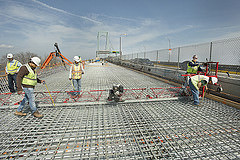

Photo by Janie Hernandez is licensed under CC BY 2.0
According to a U.N. report, the world’s population grows by two people every second, or 7,200 people an hour. More people on the planet, of course, result in more pollution, especially air pollution.
Throughout the world, leaders are demanding innovative solutions for renewable energy so that greenhouse gas emissions can be significantly reduced. Earlier this month, President Obama announced a Clean Power Plan that seeks to cut 2005 carbon emissions levels 35 percent by 2030.
There are many options for states and cities as they seek innovative ways to reduce emissions. And, though the President’s plan was announced just a few weeks ago, many government leaders were already experimenting with numerous approaches.
Although it’s common to associate renewable energy with advanced equipment, Portland, Oregon is taking a different approach by using its traditional infrastructure. The Portland Water Bureau (PWB) partnered with a renewable energy firm to, at no cost to the city or PWB, harness the power of water inside a PWB pipeline and spin 42-inch turbines to produce electricity for Portland General Electric customers.
This is the first project in the U.S. to produce energy from in-pipe hydropower in a municipal water pipeline. The city secured a 20-year power purchasing agreement with the utility. Recently, however, Salt Lake City also announced a plan to use the city’s water pipes to generate electricity. This is a new and interesting way to produce electricity and the potential for in-pipe hydropower is huge.
In a different approach, the city of Lancaster, Calif., is working toward a net-zero energy use goal and hopes to produce at least as much energy as it consumes. To accomplish this, Lancaster converted its City Hall to solar energy and launched its own power utility that will generate electricity and create a new revenue stream for the city. Lancaster was able to capitalize on its unique location which allows for year-round sun exposure as well as the de-escalating price of solar energy equipment. Lancaster may become the first net-zero city in the U.S., but meeting a net-zero demand may be a difficult goal to reach.
Beyond hydropower and solar power, wind energy has become an affordable and viable option for many states. With the price of wind energy in the United States at an all-time low, the economic competitiveness of wind energy is greatly improved. The low prices have spurred demand from both traditional electric utilities and from commercial customers.
A recent Energy Department report proclaims that wind now generates more than 20 percent of electricity used in Iowa, South Dakota and Kansas. And, in Iowa, it accounted for 28.5 percent of electricity in 2014. Just a few miles off the coast of Rhode Island, an initiative was launched to install the nation’s first commercial-scale offshore wind farm. Plans for more wind farms in Massachusetts, and potentially New Jersey and the Carolinas, are in the works.
Demand for alternative energy will continue to escalate as the price of fossil fuel energy rises and the impact of global warming become more apparent. How fast the renewable energy market develops will depend primarily on how committed public officials are to finding innovative routes to renewable energy.
Have an innovative idea for renewable energy but not sure how to sell your idea to the government? Call Strategic Partnerships and get the research and tools you need.
